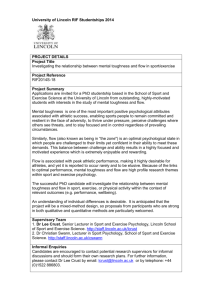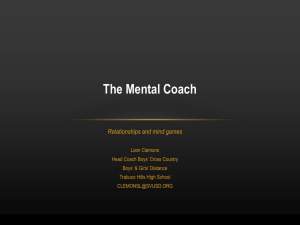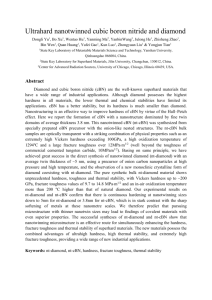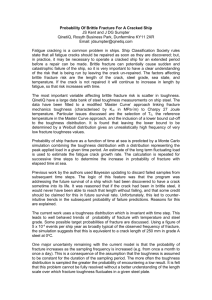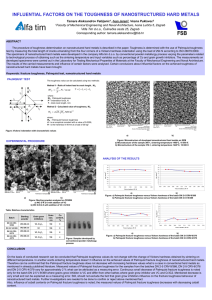Running head: MILITARY TRAINING MENTAL TOUGHNESS
advertisement
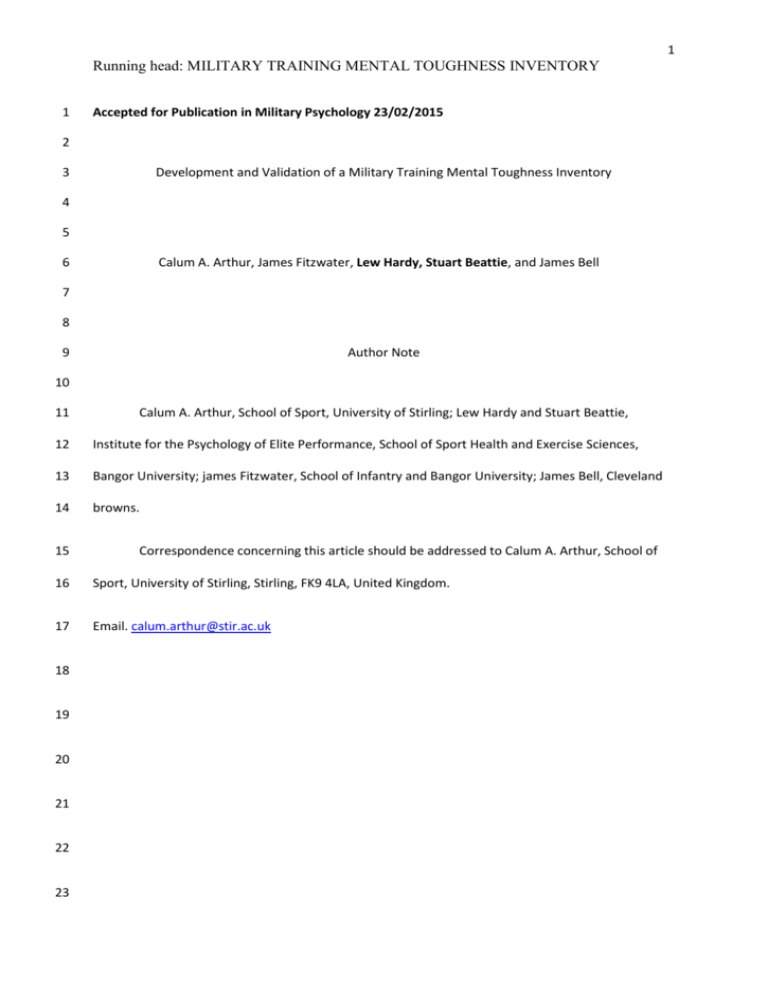
1 Running head: MILITARY TRAINING MENTAL TOUGHNESS INVENTORY 1 Accepted for Publication in Military Psychology 23/02/2015 2 3 Development and Validation of a Military Training Mental Toughness Inventory 4 5 6 Calum A. Arthur, James Fitzwater, Lew Hardy, Stuart Beattie, and James Bell 7 8 9 Author Note 10 11 Calum A. Arthur, School of Sport, University of Stirling; Lew Hardy and Stuart Beattie, 12 Institute for the Psychology of Elite Performance, School of Sport Health and Exercise Sciences, 13 Bangor University; james Fitzwater, School of Infantry and Bangor University; James Bell, Cleveland 14 browns. 15 Correspondence concerning this article should be addressed to Calum A. Arthur, School of 16 Sport, University of Stirling, Stirling, FK9 4LA, United Kingdom. 17 Email. calum.arthur@stir.ac.uk 18 19 20 21 22 23 2 MILITARY TRAINING MENTAL TOUGHNESS INVENTORY 24 Abstract 25 Three studies were conducted in order to develop and validate a mental toughness instrument 26 for use in military training environments. Study 1 (n = 435) focused on item generation and 27 testing the structural integrity of the Military Training Mental Toughness Inventory 28 (MTMTI). The measure assessed ability to maintain optimal performance under pressure 29 from a range of different stressors experienced by recruits during infantry basic training. 30 Study 2 (n = 104) examined the concurrent validity, predictive validity, and test-retest 31 reliability of the measure. Study 3 (n = 106) confirmed the predictive validity of the measure 32 with a sample of more specialized infantry recruits. Overall, the military training mental 33 toughness inventory demonstrated sound psychometric properties and structural validity. 34 Furthermore, it was found to possess good test-retest reliability, concurrent validity, and 35 predicted performance in two different training contexts with two separate samples. 36 37 38 39 40 41 42 43 44 45 46 47 Key Words: mental toughness, military, measure 3 MILITARY TRAINING MENTAL TOUGHNESS INVENTORY 48 Mental toughness has been identified by coaches and athletes as one of the most 49 crucial attributes underpinning performance excellence (e.g., Connaughton, Wadey, Hanton, 50 & Jones, 2008; Coulter, Mallet, & Gucciardi, 2010; Jones, Hanton, & Connaughton, 2002). 51 Indeed, Gould, Hodge, Peterson, and Petlichkoff (1993) reported that 82% of coaches cited 52 mental toughness as the most important psychological attribute which determined success in 53 wrestling. The research literature on mental toughness has been dominated by qualitative 54 approaches which have significantly shaped our understanding of mental toughness (e.g., 55 Bull, Shambrook, James, & Brooks, 2005; Connaughton et al., 2008; Coulter et al., 2010; 56 Gucciardi Gordon, & Dimmock, 2009a; Jones et al., 2002). However, some researchers have 57 argued that qualitative methods have become overused (e.g., Andersen, 2011), while others 58 have urged researchers to develop reliable and valid measures of mental toughness (e.g., 59 Sheard, Golby, & van Wersch, 2009). Further, Hardy, Bell and Beattie, (2013) argue that one 60 of the limitations of adopting qualitative methods is that researchers are unable to 61 differentiate between the causes of mental toughness, processes, outcomes, and other 62 behaviors that are more likely to be correlates associated with mental toughness. 63 There are however some notable exceptions to the qualitative approaches, with 64 several quantitatively derived mental toughness measures having been developed (e.g., the 65 Mental Toughness Inventory (MTI; Middleton, Marsh, Martin, Richards, & Perry, 2004; 66 2005); the Sport Mental Toughness Questionnaire (SMTQ; Sheard et al., 2009); the Mental 67 Toughness Questionnaire -48 (MTQ-48; Clough, Earl, & Sewell, 2002); the Cricket Mental 68 Toughness Inventory (CMTI; Gucciardi & Gordon, 2009). Whilst these various measures of 69 mental toughness have significantly contributed to the mental toughness literature and have 70 gone some way to alleviating the over reliance on qualitative approaches, they are not 71 without their critics (see for example, Gucciardi, Hanton, & Mallet, 2012). Hardy et al. 72 (2013) argued that whilst the above measures capture a wide array of values, attitudes, 4 MILITARY TRAINING MENTAL TOUGHNESS INVENTORY 73 cognitions and affect, they do not explicitly capture mentally tough behavior. They further 74 argue that psychological variables may influence mental toughness, or be correlates of it, but 75 that the primary focus of such measures should be on assessing the presence or absence of 76 mentally tough behavior. Hardy and colleagues also argue that the use of self-report measures 77 in assessing behaviors may be questionable due to social desirability and self-presentation 78 confounds. To this end, Hardy et al. (2013) developed an informant rated behavior based 79 Mental Toughness Inventory (MTI) in an elite sport context that was underpinned by the 80 following definition, “the ability to achieve personal goals in the face of pressure from a wide 81 range of different stressors” (p. 5). This definition of mental toughness was used to underpin 82 the current research. 83 It is important to note that researchers into the concept of mental toughness are not 84 alone in attempting to solve the dilemma of ameliorating the potential harmful effects of 85 exposure to stress. Several similar, yet subtly different constructs associated with stress 86 exposure have been proposed, defined and operationalized. These include the concepts of 87 hardiness, resilience, and grit. Hardiness is viewed as a relatively stable personality 88 characteristic, which involves courage, adaptability and the ability to maintain optimal 89 performance under exposure to stress. It has been conceptualized as a combination of three 90 attitudes; commitment, control, and challenge, which provide an individual with existential 91 courage and motivation to appraise stressful situations as opportunities for growth (Kobasa, 92 1979; Maddi, 2006; 2007). Hardiness and its core components of, commitment, control and 93 challenge are viewed as fundamental to another similar concept, resilience (Maddi, 2007). 94 Resilience is characterized by the ability to recover from negative emotional experiences and 95 the ability to adapt to stressful situations. Another similar psychological construct proposed 96 by Duckworth, Peterson, and Mathews (2007) which involves striving toward challenges and 97 maintaining effort and persistence despite adversity, setbacks and failure is termed ‘grit,’ . 5 MILITARY TRAINING MENTAL TOUGHNESS INVENTORY 98 They define grit as, “perseverance and passion for long-term goals” (Duckworth et al., 2007, 99 p. 1087), with the emphasis on long-term stamina, rather than short-term intensity. Kelly et 100 al. (2014) suggest that the concept of grit has obvious utility in the military domain in that it 101 is synonymous with fortitude or courage and the essence of officer cadet development in 102 military academies. Whilst all these psychological concepts describe psychological 103 characteristics that are undoubtedly important in a military context, they differ from the 104 current construct of mental toughness in that, the current research is specifically examining 105 mentally tough ‘behavior’. That is, the ability to maintain goal focus and high levels of 106 performance in the face of different stressors. The concepts of hardiness, resilience and grit 107 are described as a constellation of personality characteristics and are as such typically 108 measured at this level. However, mental toughness in the current research is measured and 109 conceptualized at the behavioral level. That is, whilst the behaviors will be to some extent 110 underpinned by personality, the level of measurement is not personality per se. This is an 111 important distinction that will help to further the mental toughness literature by offering a 112 means by which the personality and behavior relationship can be examined. Indeed, Hardy et 113 al. (2013) demonstrated that the current definition of mental toughness was underpinned by 114 Gray & McNaughton’s (2000) revised Reward Sensitivity Theory (rRST). 115 Hardy et al.’s. (2013) MTI has been shown to have good psychometric properties, 116 strong test-retest reliability and successfully discriminate between professional and non- 117 professional athletes. A particular strength of the MTI (which sets it apart from other 118 conceptualizations of mental toughness), is that it was conceptualized within a 119 neuropsychological theoretically driven framework, namely Gray & McNaughton’s (2000) 120 revised Reward Sensitivity Theory (rRST). rRST was used as it has the potential to offer a 121 neuropsychological explanation of the maintenance of goal directed behavior in the face of 122 stressful stimuli. Hardy et al. were successful in examining the prediction of mental 6 MILITARY TRAINING MENTAL TOUGHNESS INVENTORY 123 toughness from rRST personality traits. In a further study, the MTI was used to evaluate the 124 efficacy of a successful mental toughness training intervention (Bell, Hardy & Beattie, 2013) 125 that was underpinned by Hardy et al.’s findings. 126 The MTI and the use of rRST (Gray & McNaughton, 2000) appears to offer some 127 promise in furthering our understanding of mentally tough behavior in elite sport. 128 Consequently, based on Hardy et al.’s findings, there is a need to develop contextually 129 relevant measures of mentally tough behaviors for other settings. One particular context 130 where mental toughness is undoubtedly important is within the military. However, to date 131 there appears to have been little or no empirical research conducted on mental toughness in 132 the military domain, although there is evidence to suggest that it has recently started to be 133 explored (e.g., Hammermeister, Pickering, & Lennox, 2011). 134 Military action requires soldiers to perform under intense pressure in highly stressful 135 environments, characterized by fear, fatigue, and anxiety largely caused by risk to one’s life. 136 Typical combat stressors include, for example: exposure to enemy fire and improvised 137 explosive devices, armed combat, and seeing colleagues killed or seriously injured. To 138 demonstrate this, one soldier recently defined mental toughness as, “…gearing yourself up to 139 go on a patrol in Afghanistan, outside the wire, the day after you lost a member of your squad 140 to a sniper, and you know the sniper is still out there” (Lt Col. Burbelo; cited in 141 Hammermeister et al., 2011, p. 4). The purpose of the present study was to develop a 142 behaviorally based measure of mental toughness in a military training environment based 143 upon Hardy et al.’s (2013) definition and measure. Four independent samples, drawn from 144 general and specialized infantry training platoons from a UK-based Army training 145 establishment were employed in the study. 146 147 Study 1: Developing the Measure Method 7 MILITARY TRAINING MENTAL TOUGHNESS INVENTORY 148 Stage 1: Item Development 149 Item development was underpinned by the behaviorally based approach adopted by 150 Hardy et al. (2013). Environmental stressors were identified by conducting focus groups with 151 recruit instructors and senior military personnel. An item pool representative of typical 152 stressors experienced by recruits in training (e.g., feeling fatigued, being reprimanded, 153 pressure to perform well, etc.) was developed by the authors, which were then presented back 154 to the recruit instructors for further refinement. This resulted in a 15 item pool. 155 Participants and Procedure 156 A total of 279 infantry recruits (Mage = 21.45, SD = 3.16) who were between 5 and 24 157 weeks of training (M = 14.18 weeks, SD = 7.11) were reported on by 41 male infantry recruit 158 instructors who had served for an average of 9.03 years in the Army (SD = 2.35) and had 159 spent an average of 11.78 months as an instructor (SD = 5.89). In order for the instructors to 160 accurately assess the recruits, a minimum of 5 weeks supervision was set for inclusion 161 criteria (M = 11.73 weeks, SD = 6.84 weeks). 162 Infantry recruit instructors are responsible for training infantry recruits through a 26 163 week Combat Infantryman’s Course (CIC). They are all experienced section corporals who 164 are selected to serve a 24 month tenure at a training establishment before returning to their 165 parent unit. The aim of the CIC is to train infantry recruits to the standards required of an 166 infantry soldier to operate as an effective member of a platoon in extremely hostile 167 environments. Infantry training is therefore designed to be both physically and mentally 168 demanding with the majority of instruction and training taking place outdoors and on field 169 exercises. The consequences of failing to meet the required standards at any point in training 170 result in being reallocated to an earlier point in training with another training platoon. 171 172 After receiving institutional ethical approval, instructors and recruits were verbally solicited to take part in the study, informed of the nature of the study and the inclusion 8 MILITARY TRAINING MENTAL TOUGHNESS INVENTORY 173 criteria. Confidentiality was assured and once the inclusion criteria were satisfied, informed 174 consent was obtained. The same conditions for recruitment, participation and assurance of 175 confidentiality were applied to all of the studies in this research program. 176 The instructors were asked to complete the 15 items that were retained from stage 1 for 177 each recruit in their section and asked to rate how well they were able to maintain a high level 178 of personal performance when confronted with different stressful situations in training 179 (example items included “when the conditions are difficult” and “when he has been 180 reprimanded or punished”). Responses were based on a 7-point Likert scale that ranged 181 from 1 (never) to 7 (always), with a midpoint anchor of 4 (sometimes). 182 Results 183 Confirmatory factor analysis (CFA) using LISREL 8.80 (Jöreskog & Sörbom, 2006) 184 was used in an exploratory way to refine the item pool. The fit statistics for the 15 item 185 model was poor (χ2 (90) = 511.23, p < 0.01; RMSEA = .10, CFI = .97, NFI = .96, SRMR = 186 .06, GFI = .80). Post-hoc item refinement was conducted using the standardized residuals, 187 modification indices for theta delta and theoretical rationale. This process identified a 188 number of items that had considerable conceptual overlap with other items, were 189 ambiguously worded, or referred to environmental conditions that may not be a universal 190 stressor. Removal of these items resulted in a six item scale that demonstrated a good fit to 191 the data (χ2 (9) = 17.95, p= .04; CFI = .99, RMSEA = .03, SRMR = .02, NFI = .99, NNFI = 192 .99, GFI = .98). The mean mental toughness score was 4.17 (SD = 1.30) with an internal 193 consistency (Cronbach’s alpha) of .89. Factor loadings ranged from .72 to .81 (see Table 1 194 for items and descriptives). 195 Stage 2: Structural Validity 196 The purpose of stage 2 was to confirm the factor structure of the MTMTI on a separate 197 sample. 9 MILITARY TRAINING MENTAL TOUGHNESS INVENTORY 198 Participants and Procedure 199 A total of 156 recruits (Mage = 21.33, SD = 2.90) between weeks 7 and 23 of training 200 (M = 14.77 weeks, SD=6.49) were reported on by 23 instructors (Mage = 26.87, SD = 2.09) 201 who had served for an average of 8.48 years in the Army (SD = 2.27) and had spent an 202 average of 13.30 months as an instructor (SD = 5.46) training recruits. Instructors completed 203 the 6-item MTMTI developed in stage 1. 204 Results 205 CFA revealed that the fit statistics for the six-item model demonstrated an acceptable 206 fit to the data (χ2 (9) = 21.89: p < .01; CFI = .99, RMSEA = .07, SRMR = .03, NNFI = .98, 207 NFI = .98). The mean mental toughness score was 4.11 (SD = 1.25) with an internal 208 consistency (Cronbach’s alpha) of .91. Factor loadings ranged from .72 to .88. 209 210 Study 2: Test-retest Reliability, Concurrent and Predictive Validity Method 211 Participants 212 104 recruits (Mage = 22.07, SD = 3.92) took part in Study 2. They were reported on by 213 15 different instructors (Mage = 26.61, SD = 2.12) who had served for an average of 8.70 years 214 in the Army (SD = 2.08) and had spent an average of 12.17 months as an instructor (SD = 215 5.93). The recruits had been under the supervision of the reporting instructors for an average 216 of 17.95 weeks (SD = 5.83). 217 Instruments 218 MTMTI .The MTMTI developed and validated in Study 1 was used. 219 Concurrent validity of the MTMTI was tested by selecting variables that are theorized 220 to correlate with mentally tough behavior (e.g., self-report mental toughness, self-confidence, 221 and resilience measures). Predictive validity was tested by assessing the extent to which the 222 MTMTI predicated performance. 10 MILITARY TRAINING MENTAL TOUGHNESS INVENTORY 223 Sport Mental Toughness Inventory. The sport mental toughness questionnaire (SMTQ; 224 Sheard et al., 2009) is a 14-item measure that consists of three subscales; confidence, 225 constancy and control. These subscales can be combined to create a global measure of 226 mental toughness. The scale is measured on a 4-point Likert scale anchored at 1 (not at all 227 true) to 4 (very true). Example items include, “I have what it takes to perform well under 228 pressure” (confidence); “I am committed to completing the tasks I have to do” (constancy); 229 and, “I worry about performing poorly” (control; reverse scored). CFA has been shown to 230 provide good support for the 3-factor model (Sheard et al., 2009). 231 Self-Confidence. Self-confidence was measured using a 5-item scale that was 232 developed and validated by Hardy et al. (2010) in a military training context by asking, 233 “compared to the most confident recruit you know, how would you rate your confidence in 234 your ability to…. (e.g., “…meet the challenges of training)”. The response format is rated on 235 a 5-point Likert scale anchored at 1 (low) to 5 (high). This scale has been shown to have 236 good psychometric and predictive validity in a military training context (Hardy et al.,). 237 Resilience Scale. Resilience was measured using a 4-item resilience scale developed 238 specifically for use in a military training context by Hardy et al. (2010). The stem and 239 response format used was the same as the self-confidence scale. Example items include, 240 “…adapt to different situations in training and be successful”. This scale has been shown to 241 have good psychometric and predictive validity in a military training context (Hardy et al., 242 2013). 243 Performance. Performance was determined by the recruits’ end of course final grades, 244 based on their weekly reports and grades throughout the CIC. This grade is awarded by the 245 platoon commander (Lieutenant or Captain) and ranges from 0 (fail) to 6 (excellent). 246 Procedure 11 MILITARY TRAINING MENTAL TOUGHNESS INVENTORY 247 To assess test-retest validity, the MTMTI was administered at weeks 20 and 23 of 248 training. The self-report SMTQ, resilience and confidence scales were administered during 249 week 23 of training, and the performance data was collected at the end of training (week 26). 250 Results 251 Descriptive statistics and correlations for all study variables are displayed in Table 2. 252 The MTMTI demonstrated a good fit to the data (χ2 (9) = 6.81, p = .66; RMSEA = .00, NNFI 253 = 1.00, CFI = 1.00, SRMR = .01), although this result should be interpreted with caution due 254 to the small sample size. 255 Test-Retest Reliability 256 The mean mental toughness score at week 20 was 4.95 (SD = 1.34), and the mean score 257 at week 23 was 4.89 (SD = 1.36). A paired sample t-test revealed that these means were not 258 significantly different (t (103) = 0.63, p = > .05). The test-retest reliability for the MTMTI 259 was .72. 260 Concurrent Validity 261 Table 2 demonstrates that the MTMTI significantly correlated with the global SMTQ (r 262 = .43), the separate subscales of the SMTQ (confidence r = .37, constancy r = .40, and 263 control r = .24), and Hardy et al’s. (2010) subscales of resilience (r = .35), and confidence (r 264 = .33). 265 Predictive Validity 266 Regression analysis revealed that mental toughness significantly predicted individual 267 course performance (R² = .31; β = .56, p = < .01). Furthermore, hierarchical regression 268 analyses revealed that the MTMTI accounted for a significant proportion of variance in 269 course performance (Block 2: ∆R² = .19; β = .48, p < .01) over and above that accounted for 270 by the SMTQ (Block 1: R2 = .15; β = .19, p < .01). We also tested whether the MTMTI 271 accounted for variance in performance after controlling for all the self-report variables used 12 MILITARY TRAINING MENTAL TOUGHNESS INVENTORY 272 in the current study. The results revealed that the MTMTI accounted for a significant 273 proportion of variance in performance (Block 2: ∆R² = .18; β = .48, p < .01) over and above 274 that accounted for by all the self-report measures (Block 1: R² = .17, p < .05). 275 Study 3: Further Test of Predictive Validity 276 Study 2 demonstrated the test re-test reliability, concurrent and predictive validity of 277 the MTMTI. Furthermore the MTMTI was shown to predict performance after controlling 278 for self-reported mental toughness. The aim of Study 3 was to further test the predictive 279 validity of the MTMTI in a specialized infantry context, namely the Parachute Regiment 280 (Para). 281 While initial training for the infantry is necessarily arduous and demanding, initial 282 training for Para recruits is widely regarded by the British Army as being the most physically 283 and mentally demanding of all Infantry regiments in the British Armed Forces (Wilkinson, 284 Rayson, & Bilzon, 2008). Their specialist role requires them to operate at a higher intensity 285 than the regular infantry, carrying heavy loads for longer distances, at a faster pace as well as 286 withstanding the hardships of operating independently in the field for long periods under 287 harsh environmental conditions (Wilkinson et al., 2008). To determine their suitability for 288 this role, at week 20 of the CIC Para recruits are required to undergo a pre-Para selection test- 289 week (PPS), known colloquially as P-Company. P-Company consists of a series of 290 physically demanding team and individual events that involve carrying personal equipment 291 weighing 20kg or more for distances of up to 32km over severe terrain with time constraints, 292 a steeplechase assault course and aerial confidence course. Two team events require the 293 participants to run with a 60kg log and 80kg stretcher for 2.5km and 8km respectively. Pass 294 rates typically range between ~40-70%. 295 Furthermore, the nature of the military performance indicators is such that they tend to 296 be very physical in nature. However, whilst a specific level of fitness is required for military 13 MILITARY TRAINING MENTAL TOUGHNESS INVENTORY 297 service, the various tests are designed to assess recruits abilities to perform under stressful 298 and arduous conditions. That is, it is not just fitness that determines the quality of a Para 299 recruit but the ability to maintain a high level of performance in stressful and arduous 300 conditions. Success on P-Company entitles a recruit to wear the coveted maroon beret and 301 pass out of training into a Parachute Regiment unit. Conversely, failure results in the recruit 302 being reallocated to a platoon earlier in the training cycle or transfer to another infantry 303 regiment. The recruits have been training for this test week for the preceding 20 weeks. 304 It is hypothesized that fitness will predict performance on P-Company but, more 305 importantly, mental toughness will predict variance in performance on P-Company after 306 controlling for fitness. 307 Method 308 Participants 309 Participants for Study 3 were 134 Para recruits (Mage = 19.95, SD = 4.14) who were 310 reported on by 20 different Para recruit instructors (Mage = 28.71 years, SD = 2.92) who had 311 served for an average of 10.65 years in the Army (SD = 2.63) and had spent an average of 312 10.95 months as an instructor (SD = 4.87). The recruits had been under the supervision of 313 their respective instructors for between 7 and 20 weeks (M = 15.31 weeks, SD = 4.06). 314 Instruments 315 Mental Toughness 316 The MTMTI was used to measure mental toughness. 317 Performance 318 During P-Company, participants can achieve a maximum of 70 points, determined by 319 their performance on each event (i.e., up to 10 points for each of the 7 events; the aerial 320 confidence course is a pass or fail test). Most of the points are awarded objectively based on 321 time to complete or completion of an event and are awarded by P-Company staff who are 14 MILITARY TRAINING MENTAL TOUGHNESS INVENTORY 322 independent of the recruits’ regular training team. Performance scores in the current sample 323 ranged from 10-70 (M = 49.95, SD = 15.07). 324 Fitness 325 An objective measure of fitness was used to control for individual fitness. During 326 training, recruits are required to complete physical assessments to measure progression in 327 individual fitness. One of these assessments is a two-mile loaded run in less than 18 minutes, 328 carrying a 16 kg pack and rifle. Another assessment is a timed run over a steeplechase 329 assault course consisting of several dry and water obstacles. Each event generates an 330 individual time. Two-mile loaded times for this cohort ranged from 15 minutes and 30’s to 331 22 minutes and 47’s (M = 18:39, SD = 1:37). The steeplechase times ranged from 18 332 minutes 30’s to 22 minutes 26’s (M = 20:19, SD = 1:08). In order to create an overall 333 indication of fitness these times were standardized within event and were then combined to 334 create an overall score. We then multiplied the overall score by -1 so that a higher score was 335 indicative of better performance. 336 Procedure 337 The fitness tests were conducted during week 18 of training and the MTMTI was 338 administered at the end of week 19 of training. P-Company was conducted at week 20 of 339 training. 340 Results 341 Descriptive statistics and correlations for all study variables are displayed in Table 2. 342 Consistent with Studies 1 and 2, the MTMTI demonstrated a good fit to the data (χ2 (9) = 343 14.07, p = 0.12; RMSEA = .06, NNFI = .99, CFI = 1.00, SRMR = .03). The mean mental 344 toughness score was 4.94 (SD = 1.02) with an internal consistency (Cronbach’s alpha) of .87. 345 Factor loadings were all above .63. 15 MILITARY TRAINING MENTAL TOUGHNESS INVENTORY 346 Regression analysis revealed that mental toughness significantly predicted individual P 347 Company performance (R² = .14; β = .36, p = < .01). Moreover, hierarchical regression 348 analysis revealed that MTMTI predicted variance in performance (Block 2: ∆R² = .06, β = 349 .26, p = < .01) over and above that accounted for by the fitness measure (Block 1: R² = .15, β 350 = .30, p = < .01). 351 Discussion 352 The purpose of the present series of studies was to develop and validate a measure of 353 mentally tough behavior in a military training environment. Study 1 found good support for 354 the structural validity of the MTMTI, while Study 2 found support for the concurrent, 355 predictive, and test retest reliability. The predictive validity of the MTMTI was further 356 supported in a specialized infantry sample. Moreover, the predictive validity tests 357 demonstrated that the MTMTI predicted objective performance while controlling for another 358 measure of mental toughness (SMTQ in Study 3) and fitness (in Study 4). Overall, the 359 MTMTI demonstrated good psychometric properties across 4 separate samples and the 360 predictive validity was supported in two separate samples. Consequently, these results 361 provide some further support for Hardy et al.’s (2013) proposal that mental toughness should 362 be assessed via observer rather than self-report ratings. 363 The current research is an important first step in developing a valid measure of mental 364 toughness in a military context. Having a valid scale that stands up well to both 365 psychometric and predictive testing allows researchers to examine mental toughness both 366 from applied and theoretical perspectives that will help to further our understanding of 367 mentally tough behavior. For example, the current measure will allow for further exploration 368 of the neuropsychological underpinnings of mentally tough behavior across contexts. 369 Namely, whether Hardy et al. (2013) counter intuitive finding that mentally tough behavior 370 was related to high levels of punishment sensitivity and low levels of reward sensitivity in 16 MILITARY TRAINING MENTAL TOUGHNESS INVENTORY 371 cricketers (see Gray & McNaughton, 2000 for a review of reward and punishment sensitivity, 372 and Hardy et al., for a description of how reward and punishment sensitivities might be 373 related to mental toughness). It would seem prudent to examine these results across different 374 contexts. 375 Based on the findings from Hardy et al. (2014), Bell et al. (2013) developed a 376 successful multimodal intervention that was designed to impact mental toughness in elite 377 level cricketers. Consequently, the MTMTI could potentially be used to conduct similar 378 interventions to evaluate mental toughness in a military training environment. The 379 intervention contained three main components; exposure to punishment conditioned stimuli, 380 coping skills training, and was delivered in a transformational manner. Whilst the results of 381 the intervention indicated that it was successful in developing mental toughness by the 382 authors own admission, no attempt was made to measure the separate effects of the 383 punishment conditioned stimuli, the transformational delivery, or the efficacy of the coping 384 skills. Thus, no conclusions can be inferred regarding which aspects of the intervention 385 contributed most to the observed change in mental toughness, or indeed, whether these 386 aspects interacted to impact the observed change in mental toughness. Consequently, further 387 research is needed to delineate more precisely the effects that punishment conditioned 388 stimuli, transformational delivery, and coping skills has on the development of mental 389 toughness. 390 Whilst the current measure has been demonstrated to perform well in the standard 391 tests of measurement efficacy it is noted that the scale is one-dimensional, that is, all the 392 stressors fall under one global aspect. It is suggested that it might be possible to delineate the 393 stressors into clusters. For example, some of the stressors identified in the MTMTI may fall 394 under physical stress (e.g., tiredness) whilst others about threats to ego (e.g., punishments). 395 Further investigation of this would seem warranted. For example, all of the social pressure 17 MILITARY TRAINING MENTAL TOUGHNESS INVENTORY 396 items (e.g., “he is not getting on with other section members”) were deleted at stage 1 due to 397 inadequate fit. Indeed, the inclusion of a multidimensional aspect to the measurement of 398 mentally tough behavior will allow for a closer examination of the construct of mental 399 toughness. This would allow for more in-depth questions around mental toughness to be 400 examined, such as, whether some individuals are better able to cope with certain types of 401 stressors than other types of stressors (e.g., social stressors, threats to ego, physical stressors 402 etc.). Furthermore, the role that underlying personality dimensions have in determining 403 individual differences in ability to cope with different types of stressors would also be a 404 worthwhile area of future research. However, in order to test these and other related questions 405 one would need to develop a multidimensional measure of mentally tough behavior. A further 406 limitation and area worthy of future research is to explore the possibility of whether the 407 current anchors should be more reflective of behaviors rather than a Likert type scale. 408 To sum up the current series of studies have gone some way toward developing and 409 validating a measure of mental toughness in a military training environment that will 410 hopefully stimulate further theoretical and applied research in this area. 411 412 413 18 MILITARY TRAINING MENTAL TOUGHNESS INVENTORY 414 415 References Andersen, M. B. (2011). Who’s mental, who’s tough and who’s both? Mutton constructs 416 dressed as lamb. In D. F. Gucciardi and S. Gordon (Eds.), Mental toughness in 417 sport: Developments in theory and research (pp. 69-88). Oxon: Routledge. 418 Bell, J., Hardy, L., & Beattie, S. (2013). Enhancing mental toughness and performance 419 under pressure in elite young cricketers: A 2 year longitudinal intervention. Sport, 420 Exercise, and Performance Psychology, 2, 281-297. DOI:10.1037/a0033129 421 Bull, S. J., Shambrook, C. J., James, W., & Brookes, J. E. (2005). Towards an 422 understanding of mental toughness in elite English cricketers. Journal of Applied 423 Sport Psychology, 17, 209-227. DOI: 10.1080/10413200591010085 424 Clough, P., Earle, K., & Sewell, D. (2002). Mental toughness: The concept and its 425 measurement. In I Cockerill (Ed.), Solutions in sport psychology (pp. 32-43). 426 London: Thompson. 427 Connaughton, D., Wadey, R., Hanton, S., & Jones, G. (2008). The development and 428 maintenance of mental toughness: Perceptions of elite performers. Journal of Sports 429 Sciences, 26, 83-95. DOI:10.1080/02640410701310958 430 Coulter, T. J., Mallett, C. J., & Gucciardi, D. F. (2010). Understanding mental toughness 431 in Australian soccer: Perceptions of elite performers. Journal of Sports Sciences, 28, 432 699-716. DOI:10.1080/02640411003734085 433 Crust, L., & Azadi, K. (2010). Mental toughness and athletes’ use of psychological 434 strategies. European Journal of Sport Science, 10, 43-51. DOI: 435 10.1080/17461390903049972 436 Duckworth, A. L., Peterson, C., Matthews, M. D., & Kelly, D. R. (2007). Grit: Perseverance and 437 passion for long term goals. Journal of Personality and Social Psychology, 92, 1087–1101. 438 DOI: 10.1037/0022-3514.92.6.1087 19 MILITARY TRAINING MENTAL TOUGHNESS INVENTORY 439 Gray, J. A., & McNaughton, N. (2000). The neuropsychology of anxiety: An enquiry into 440 the functions of the septo-hippocampal system. Oxford, UK: Oxford University 441 Press. 442 Gucciardi, D. F., & Gordon, S. (2009). Development and preliminary validation of the 443 Cricket Mental Toughness Inventory. Journal of Sports Sciences, 27, 1293-1310. 444 DOI:10.1080/02640410903242306 445 Gucciardi, D. F., Gordon, S., & Dimmock, J. A. (2009a). Development and preliminary 446 validation of a mental toughness inventory for Australian football. Psychology for 447 Sport and Exercise, 10, 201-209. DOI:10.1016/j.psychsport.2008.07.011 448 Gucciardi, D. F., Gordon, S., & Dimmock, J. A. (2009b). Evaluation of a mental toughness 449 training program for Australian footballers: 1. A quantitative analysis. Journal of 450 Applied Sport Psychology, 21, 307-323. DOI:10.1080/10413200903026066 451 Gucciardi, D. F., Hanton, S., & Mallet, C. L. (2012). Progressing measurement in mental 452 toughness: A case example of the Mental Toughens Questionnaire 48. Sport, 453 Exercise, and Performance Psychology, 1(13), 194-214. DOI:10.1037/a0027190. 454 Hammermeister, J., Pickering, M., & Lennox, A. (2011). Military applications of 455 performance, psychology methods and techniques: An overview of practice and 456 research. The Journal of Performance Psychology [e-journal], 3. Available through: 457 Centre for Performance Psychology [Accessed 28th January 2013]. 458 Hardy, L., Arthur C.A., Jones, G., Shariff, A., Munnoch, K., Isaacs, I., Allsopp, A.J. (2010). 459 The relationship between transformational leader behaviors, psychological, and 460 training outcomes in elite military recruits. The Leadership Quarterly, 21, 20-32. 461 DOI:10.1016/j.leaqua.2009.10.002. 462 463 Hardy, L., Bell, J., & Beattie, S. (2014). A neuropsychological model of mentally tough behaviour. Journal of Personality, 8, 69-81. DOI: 10.1111/jopy.12034 20 MILITARY TRAINING MENTAL TOUGHNESS INVENTORY 464 Jones, G., Hanton, S., & Connaughton, D. (2002). What is this thing called mental 465 toughness? An investigation of elite sport performers. Journal of Applied Sport 466 Psychology, 14, 205-218. DOI:10.1080/10413200903026066 467 468 Joreskog, K. G., & Sorbom, D. (2006). Lisrel 8 (version 8.0). [Computer software]. Chicargo: Scientific Software International. 469 Kelly, D. R., Mathews, M. D., & Bartone, P. T. (2014). Grit and hardiness as predictors of 470 performance among West Point cadets. Military Psychology, 26, 327-342. 471 doi.org/10.1037/mil0000050 472 Kobasa, S. C. (1979). Stressful life events, personality, and health: An inquiry into hardiness. Journal 473 of Personality and Social Psychology, 37, 1–11. DOI: 10.1037/0022-3514.37.1.1 474 Loehr, J. E. (1986). Mental toughness training for sports: Achieving athletic excellence. 475 476 477 478 479 480 Lexington, MA: Stephen Greene. Maddi, S. R. (2006). Hardiness: The courage to grow from stresses. Journal of Positive Psychology, 1, 160–168. DOI: 10.1080/17439760600619609 Maddi, S. R. (2007). Relevance of hardiness assessment and training to the military context. Military Psychology, 19, 61–70. Maddi, S. R., Mathews, M. D., Kelly, D. R., Villareal, B., & White, M. (2012). The role of hardiness 481 and Grit in predicting performance and retention of USMA cadets. Military Psychology, 482 24,19-28. DOI: 10.1080/08995605.2012.639672 483 Middleton, S. C., Marsh, H. W., Martin, A. J., Richards, G. E., & Perry, C. (2004). 484 Developing the mental toughness inventory. Self Research CentreBiannual 485 Conference, Berlin. 486 Middleton, S. C., Marsh, H. W., Martin, A. J., Richards, G. E., & Perry, C. (2005). 487 Developing a test for mental toughness: The mental toughness inventory. AARE 488 Conference, Sydney. 489 Sheard, M., Golby, J., & van Wersch, A. (2009). Progress toward construct validation of the 21 MILITARY TRAINING MENTAL TOUGHNESS INVENTORY 490 sports mental toughness inventory (SMTQ). European Journal of Psychological 491 Assessment, 25, 186-193. DOI 10.1027/1015-5759.25.3.186 492 Wilkinson, D. M., Rayson, M. P., & Bilzon, J. L.J. (2008). A physical demands analysis of 493 the 24-week British Army Parachute Regiment recruit training syllabus. Ergonomics, 494 51, 649-662. DOI: 10.1080/00140130701757367 22 Running head: MILITARY TRAINING MENTAL TOUGHNESS INVENTORY Table 1. Standardized factor loadings, means and standard deviations for retained items. 4 Study 1a (n = 279) FL M (SD) Study 1b (n = 156) FL M (SD) Study 2 (wk 20) (Study 2 wk 23) (n = 104) FL M (SD) FL M (SD) Study 3 (n = 134) FL M (SD) 1 His recent performances have been poor. 0.72 4.23(1.50) 0.82 4.08(1.52) 0.64 4.57(1.82) 0.86 4.95(1.40) 0.63 4.81(1.26) 2 He is in pain (e.g., associated with high levels of physical effort). 0.77 4.06(1.78) 0.74 3.98(1.59) 0.75 4.86(1.76) 0.87 4.89(1.60) 0.66 4.78(1.48) 3 The conditions are difficult (e.g., on exercise). 0.80 4.22(1.55) 0.88 4.12(1.49) 0.82 5.05(1.55) 0.90 4.91(1.58) 0.87 5.00(1.22) 4 He has been reprimanded/punished 0.81 4.06(1.68) 0.75 4.41(1.61) 0.82 5.11(1.56) 0.83 4.90(1.51) 0.69 5.06(1.19) 5 He has not had much sleep 0.74 4.04(1.51) 0.82 3.87(1.36) 0.85 4.95(1.50) 0.85 4.79(1.52) 0.80 4.78(1.24) 6 He is under pressure to perform well (e.g., assessments, test conditions) 0.73 4.41(1.62) 0.72 4.22(1.53) 0.79 5.23(1.65) 0.84 4.88(1.58) 0.75 4.92(1.36) Total Mental Toughness 4.17(1.30) Note. FL is the standardized factor loading 4.11(1.25) 4.95(1.34) 4.89(1.36) 4.89(1.01) 23 MILITARY TRAINING MENTAL TOUGHNESS INVENTORY Table 2. Means, SDs, and inter-correlations between variables in studies 2 and 3 with alpha coefficients in parenthases Mean SD 1 2 3 4 5 6 7 8 Study 2 (n = 104) 1 Mental Toughness (wk 20) 4.95 1.34 (.90) 2 Mental Toughness (wk 23) 4.89 1.36 .72** (.94) 3 SMTQ 2.98 0.40 .33** .43** (.78) 4 SMTQ-Confidence 3.08 0.48 .27** .37** .83** (.66) 5 SMTQ-Constancy 3.38 0.45 .31** .40** .75** .51** (.45) 6 SMTQ-Control 2.42 0.61 .20* .24* .74** .33** .40** (.62) 7 Resilience 3.94 0.70 .32** .35** .68** .62** .52** .46** (.81) 8 Self-confidence 4.12 0.63 .25** .33** .71** .72** .52** .38** .75** (.85) 9 Final Course Grade 4.05 1.57 .33** .56** .39** .33** .39** .23* .33** .35** Study 3 (n = 134) Mean SD 1 2 3 1 Mental Toughness 4.89 1.01 (.87) 2 P Company Score 47.25 17.63 .36** 3 Fitness Score 0.03 0.74 .43** **p = < .01 *p = < .05 .42** 9

